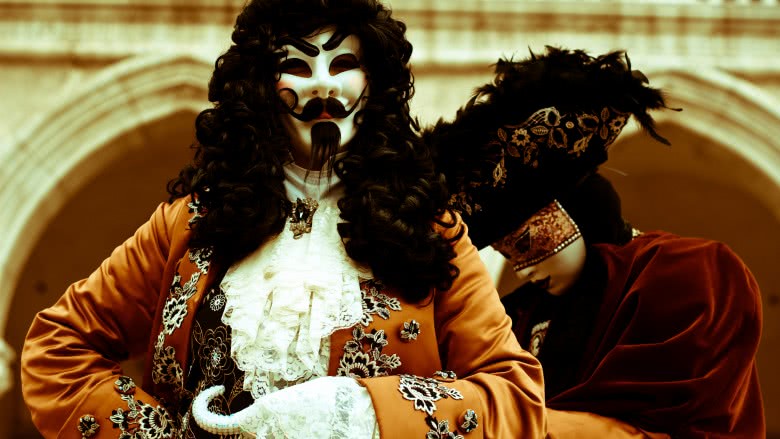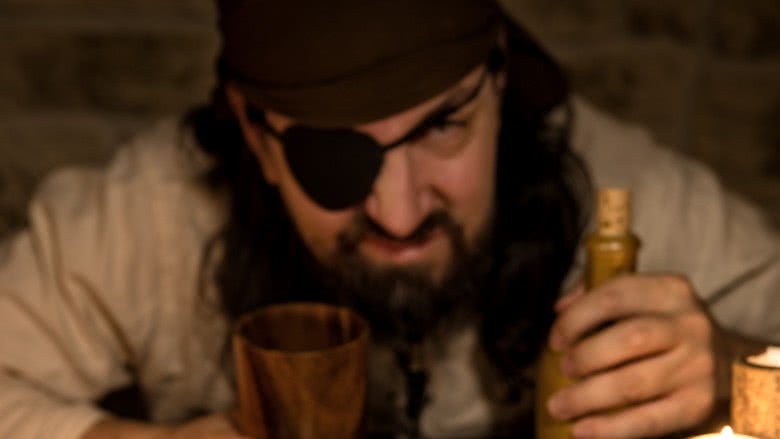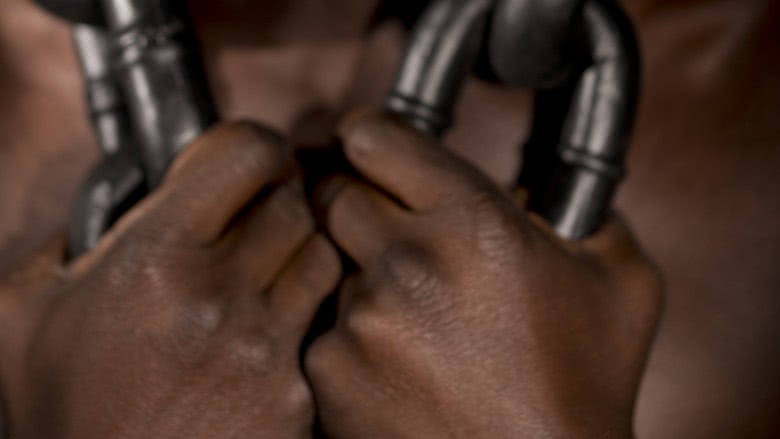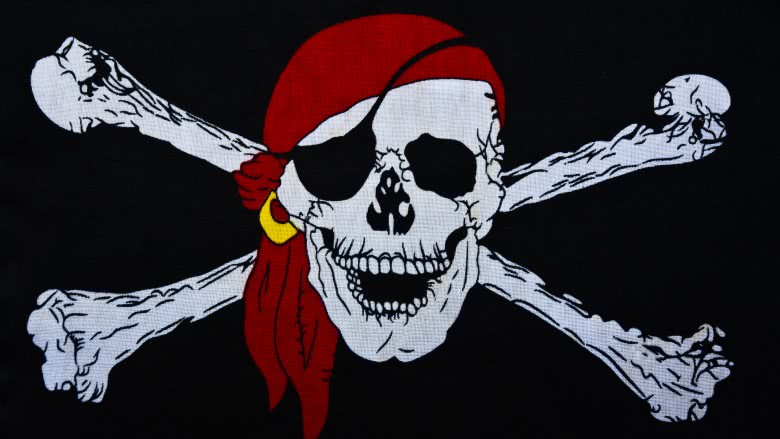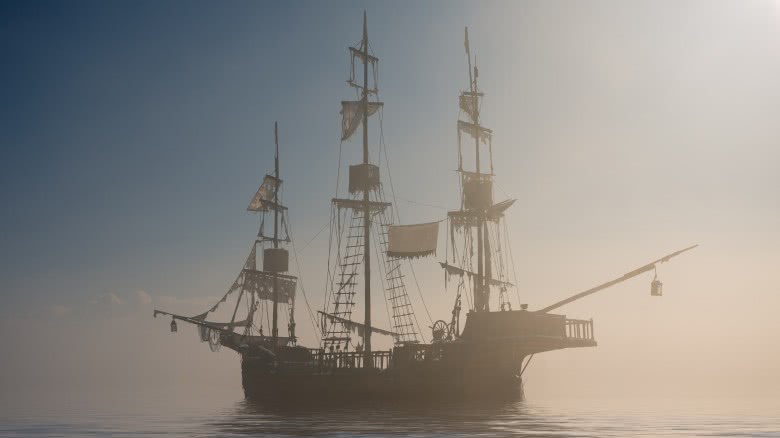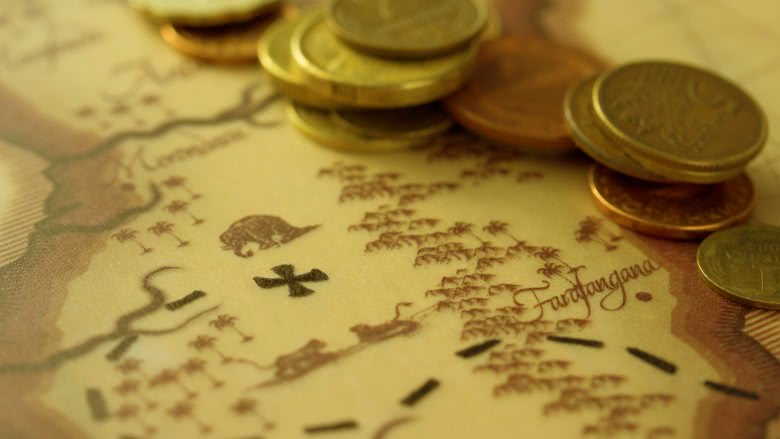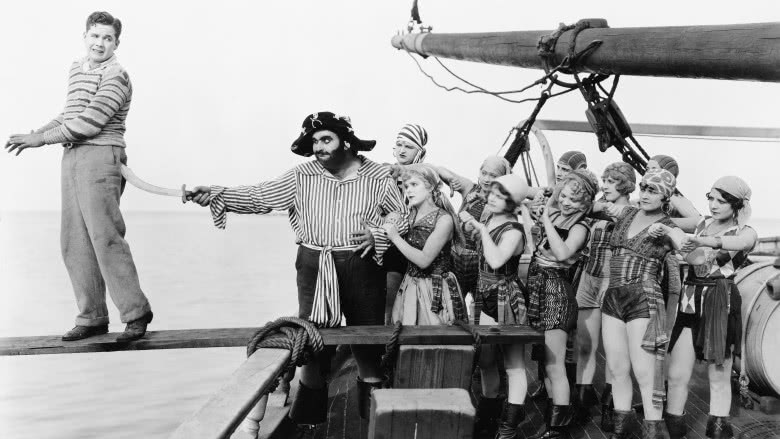False Facts About Pirates Everyone Thinks Are True
Since Robert Louis Stevenson penned Treasure Island in 1883, pirates have fascinated people the world over. From the uber-popular Pirates of the Caribbean movies to television series Black Sails to one of the most expensive pornographic films ever made, pirates have dominated the worlds of fantasy. Unfortunately, most of the things we think we know about pirates are just that: fantasy. There's a lot of falsehoods sailing the high seas of our imagination, and it's time we captured them, tied them up, and marooned them on a deserted island.
Pirates spoke like pirates
September 19 is National Talk Like a Pirate Day, but it should probably be renamed National Talk Like a Hollywood Pirate Day, as that's exactly where the likes of "hornswaggle" and "landlubber" originate.
It's tough to know definitely how pirates really spoke, as there aren't television interviews and radio broadcasts with pirates collecting dust in the archives, and pirates weren't exactly the most literate bunch. According to historian Colin Woodard, almost every example of pirate writing, penned from an actual pirate, came from more educated individuals who turned to a life piracy and thus most certainly did not say things like "arr, matey." In fact, scholars agree that pirates spoke almost identically to your standard merchant sailor, so their English wasn't particularly atrocious.
So where did everyone get the idea that pirates were walking around shouting "shiver me timbers?" According to Woodard, there's one specific source to blame, and you've probably seen it yourself: Disney's 1950 pirate film Treasure Island, starring Robert Newton as Long John Silver. Newton's take on pirate was massively popular, reshaping our image of pirates while ingraining his specific rendition of pirate-speak into popular consciousness, inspiring virtually every pop-culture pirate that would follow, including Captain Hook. Newton used his native dialect from the southwest of England, which is where those infamous "arrs" come from, but considering piracy was a multi-ethnic and international affair, with English pirates tending to hail from London, it's safe to assume this particular West Country dialect was anything but prevalent.
So if you're keen on really talking like a pirate on September 19, you'd best brush up on your early 1900s merchant-sailor-from-London speech, and send that other nonsense back to Davey Jones's locker, where it belongs.
They were all men
Even with the likes of Elizabeth Swan, played by Keira Knightley, making her presence known in the Pirates of the Caribbean series, most people automatically conjure images of bearded male swashbucklers when tasked to think of a pirate. In fact, it was often considered bad luck to even have a woman aboard a ship! Nonetheless, female pirates abound, challenging their male counterparts in notoriety.
Laura Sook Duncombe challenges the common perception that piracy was an exclusively male profession in her book Pirate Women: The Princesses, Prostitutes, and Privateers Who Ruled the Seven Seas. Sure, everyone knows about Captain Kidd, Calico Jack, and Blackbeard, but few know of the mid-16th-century Moroccan pirate queen Sayyida al-Hurra, or of Lady Mary Killigrew, in the time of Queen Elizabeth I. Some people surely know about famous female buccaneers Anne Bonny and Mary Read, but they probably don't know that the pair were just as ruthless as any men of the same cloth.
There's also a common belief that most female pirates had to pretend to be men, to be permitted to plunder with the rest of 'em. Surely some women did have to hide their identity, but many women, as Duncombe points out, spurned the disguise. "Many of them," she tells Smithsonian, "dressed like women. They were not in disguise, so clearly they could maintain some semblance of outward femininity while aboard these ships." The author tells of an Irish pirate who likely held a sword on one hip with her baby on another, illustrating that outward femininity was not necessarily a problem.
So get that all-male notion of piracy out of your head. Just look at Captain Jack Sparrow. He's already toeing the boundary.
They wore eye patches to cover an empty eye socket
Did some pirates wear eye patches to cover up an empty eye socket? Possibly. But there's also plenty of speculation that the eye patch served an important purpose for those with both ocular globes intact.
Have you ever stared into your bathroom mirror, turned off the lights for a few minutes, and then turned them back on, to watch those dark holes in your eyes go from wide-open to teeny-weeny real fast? Or have you ever used your smartphone at maximum brightness in the middle of the night and regretted it almost immediately? Long story short, your retinas open up when it's dark, to let in more light, and likewise shrink when it's bright, to let in less light. This is why going from a dark space to a light space, or vice versa, requires some time for your eyes to adjust, and this may also account for why pirates wore eye patches.
The reasoning goes that it'd be quicker and easier to go below deck if you could just switch that eye covered by the patch, so one eye was always acclimated to the dark. We can't definitively know if pirates wore eye patches for this reason, as first-person accounts from pirates are virtually nonexistent, but this is a plausible theory.
MythBusters put this theory to the test by completing tasks in a dark room, once with light-accustomed eyes, and once with a single eye, which had been covered with a patch for 30 minutes. It was much easier to accomplish the task with an eye already acclimated to the dark. Furthermore, Thomas J. Tredici points out in Aerospace Ophthalmology that "even though a bright light may shine in one eye, the other will retain its dark adaptation, if it's protected from the light. This is a useful bit of information, because a flyer can preserve dark adaptation in one eye by simply closing it."
Not buying it? Well then, head to the local dollar store, buy an eye patch, and try it for yourself! We just recommend you do it at home, to avoid a lot of weird looks on the street.
They were all white
Virtually every image of a pirate is of that of a white male, but nothing could be more inaccurate.
According to Kenneth Kinkor, a leading pirate expert, pirate crews were multiethnic, with many crews featuring upward of one-third black individuals, most of which, reports The Los Angeles Times, were freed slaves, who had equal rights when it came to loot, voting, and the possibility to attain captainship. "The deck of a pirate ship," says Kinkor, "was the most empowering place there was for a black man during the 18th century," which is certainly understandable, given that pirates weren't entirely keen on social standards and typical societal norms.
As the North Carolina Department of Natural and Cultural Resources argues, skin color wasn't what mattered to pirates. What really mattered was an individual's abilities and skill set, and how useful one would be in the crew. History leads us to believe black pirates, who were often liberated from plundered slave ships, enjoyed a freedom aboard a pirate ship that would be unimaginable on land. Slaves on raided plantations were also sometimes offered the opportunity to join the pirate crew, with its lure of freedom, guns, and booze.
It would be unfair and incorrect to assume that all white pirates treated blacks as equals. Undoubtedly, some were treated as slaves, and ingrained racial prejudices didn't exactly just disappear on the high seas. Still, given recent research and what we know about the pirates' way of life, it's easy to see why a pirate ship was one of the best places, if not the best place, for a black individual in the time of rampant slavery.
They all flew the same flag
The image of the pirate is synonymous with the stereotypical pirate flag: a skull and crossbones against a black background. Yet this flag was most certainly not flown by pirates the world over. In fact, barely anybody flew this flag. Even better, almost every pirate flag you can imagine is fake.
According to Benerson Little's definitive The Golden Age of Piracy: The Truth Behind Pirate Myths, the idea that pirates flew the skull and crossbones is totally a myth, with the image of them wearing it on their clothing even more inaccurate. Henry Every never hoisted a black flag with a skull and crossbones, and there's nothing to prove Thomas Tew flew a black flag with an arm wielding a sword. Captain Kidd never flew under a black flag, instead opting for English colors, or some kind of deep red creation. Pretty much every pirate flag you can think of is, as Little states, "a modern [invention] without historical basis," and even those that are at least marginally correct are misattributed. According to Little, the perpetuation of the partially or entirely false pirate flags are down to little more than marketing.
In short, pirate flags are sexy ... and sexy sells. Unfortunately, there's no tangible evidence to suggest that the most iconic pirate flags were particularly common, or even real, in some cases. For all we know, the real flags of pirates were total snoozefests.
They were lawless
Pirate ships are often depicted as reckless and lawless places where drunken rowdiness rules and mutiny is always a possibility. However, recent research suggests pirate ships were well organized and sophisticated, balancing power and exercising democracy.
Crews on pirate ships were diverse, often comprising freed slaves and volunteers, with little tying individuals to each other outside of the job. According to The New Yorker, "pirate ships were governed by what amounted to simple constitutions that, in greater or lesser detail, laid out the rights and duties of crewmen, rules for the handling of disputes, and incentive and insurance payments to insure crewmen would act bravely in battle." Pirates were keen on democratic rule, as many had sailed previously under the autocratic rule of the Royal Navy, making sure power was, according to economist Peter Leeson, both divided and limited. Captains and quartermasters were elected, and their positions were not guaranteed. Spoils were divided more or less equally, as was dictated and agreed upon in writing, and juries were in charge of judging alleged crimes. They even were apt to treat their prisoners well, as this encouraged ships to surrender rather than fight, making for easier pickings. All things considered, your standard pirate ship was a more fair and democratic workplace than your current job.
Sure, pirates weren't exactly the nicest people around. As pirate expert Kenneth Kinkor puts it, "They were nasty, brutal and vicious people. But they lived in an age that was extraordinarily nasty, brutal and vicious." The bottom line is: if you lived in the golden age of piracy, working on a pirate ship certainly wasn't the worst thing you could do.
They liked to bury their treasure
One thing we know pirates were good at is burying their treasure and making maps to find it. X marks the spot, right?
Wrong! Turns out, pirates weren't really that big on burying treasure. In fact, there's only a couple recorded cases in which we can assume a pirate buried their booty. The first comes from the legendary Francis Drake, who apparently buried more than a few tons of Spanish gold and silver somewhere along the Panamanian coast, as players of the Uncharted video game series know all about. The second case is Captain Kidd, who allegedly buried millions of dollars' worth of goodies on Gardiners Island. Unfortunately for Kidd, he was hanged before he could ever get back to it.
Like pretty much every pirate myth, the idea that pirates buried their treasure stems from Robert Louis Stevenson's 1883 novel Treasure Island. Burying valuables, however, doesn't really make much sense, and pirates were far more keen on spending, rather than saving. Historian David Cordingly reckons that most pirates would blow their loads "on women, rum and gambling as soon as they returned to port."
If we were pirates, we too would rather spend our spoils than bury them somewhere in the dirt. If you don't use it, you lose it ... as Captain Kidd found out the hard way.
They made people walk the plank
We've all seen the movies, and we've all made our friends do it into a swimming pool. If popular culture is to be believed, making prisoners and mutineers walk the plank was all the rage in the privateer days. But alas, popular culture isn't to be believed, as it's been responsible for more pirate myths than you can shake a peg leg at.
According to The Los Angeles Times, there's only one recorded instance in which pirates made someone walk the plank. One!
If pirates aboard a ship were interested in drowning someone, they were far more likely to simply throw the poor lad overboard. Making someone walk the plank would just be unnecessarily theatrical, though pirates were apparently fond of a good marooning.
It was, you guessed it, Robert Louis Stevenson's Treasure Island that brought walking the plank into the popular consciousness ... though, this time, he wasn't alone. Daniel Defoe originated the idea, and authors Charles Ellms and Howard Pyle joined in on the fun, all ingraining the plank-walking myth into the minds of their readers.
Sorry to burst your bubble, but walking the plank simply didn't happen. If you were bad aboard a pirate ship, more likely than not, you just got flogged ... which would suck, too.

